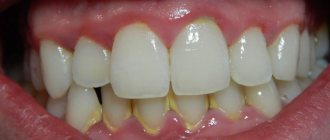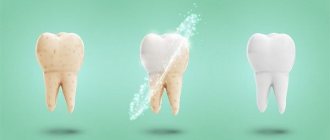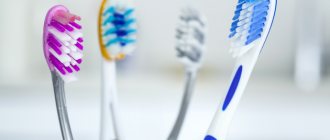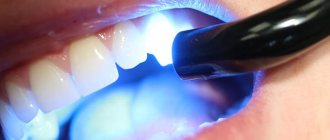Classification
Dental deposits are divided into:
- soft non-mineralized: dental plaque,
- dental plaque;
- tartar.
Dental plaque is a thin film on the surface of the tooth, consisting of living and dead microorganisms and food debris, which does not have a permanent structure, is formed within an hour after brushing the teeth, is easily cleaned with a toothbrush, but after 48 hours its structure becomes more dense and viscous and leads to the formation of dental plaque.
Dental plaque is a sticky, sticky dental plaque that has a grayish tint and consists of microorganisms, components of saliva, bacterial metabolic products, firmly fixed on the surface of the tooth enamel. As a result of the activity of bacteria in dental plaque, organic acids are produced that destroy tooth enamel, which creates all the conditions for the development of caries, gingivitis and periodontitis.
Dental plaque usually appears in places that are difficult to reach for brushing: between the teeth, on their inner surface, under the gums. It can be light yellow, greenish or brown. 12 days after the formation of dental plaque, as a result of the active activity of bacteria, the pH of saliva increases, and deposits of calcium and phosphorus salts occur. This process is called mineralization and is the cause of the formation of tartar.
Dental stones according to their location are divided into:
- supragingival calculus,
- subgingival calculus.
Supragingival - located above the gums, they are easy to see independently on the surface of the tooth in the form of deposits from light yellow to dark brown, most often they are formed on the inside of the teeth or on the interdental side.
Subgingival - located deep in the gums, in gingival or periodontal pockets, they are brown in color, their presence can only be determined during examination by a dentist. Subgingival tartar forms in almost all people after 40 years of age and often leads to tooth loss.
How does plaque form?
During the formation process, plaque goes through three phases:
- 1st phase (lasts for 1.5-3 hours after cleansing teeth with toothpaste). At this stage, up to 1 million different bacteria and microorganisms may be present in the oral cavity, for example, staphylococci, lactobacilli, streptococci. During the specified time, these microorganisms actively multiply;
- 2nd phase of plaque formation (lasts about 3-6 hours after cleansing teeth with toothpaste). During the specified time, the teeth are covered with a thin film of plaque, which is invisible to the naked eye. By this time, there are already about 10 million microorganisms in the oral cavity;
- 3rd phase (5-6 days after the last toothpaste cleansing). After this phase of plaque formation, several hundred billion pathogenic bacteria already live in the oral cavity. The plaque is fully formed and has distinct contours. The resulting plaque already contains bacteria of infectious etiology.
Methods of prevention and treatment
Both prevention and treatment come down to careful and thorough oral care. It is necessary to strictly follow the rules in order to protect yourself from the formation of pathological plaque:
- Brushing your teeth twice a day – morning and evening, for at least 2 minutes, and using properly selected products. It is important to use a brush with medium-hard bristles (even if gum inflammation is present); one that is too soft will not cope with deposits,
- using dental floss and irrigator after every meal,
- using interdental brushes to help clean narrow spaces between teeth,
- Visit your dentist every six months for a checkup.
But you should understand that even with careful hygiene, plaque will still accumulate. For example, under the gums. And even if you missed cleaning at least once or were unable to use the product after meals, especially against the background of reduced immunity or hormonal changes, plaque will again accumulate in greater quantities. Therefore, it is very important to periodically seek help from a dentist for professional oral hygiene.
Professional oral hygiene The procedure allows you to quickly and effectively remove plaque and tartar, as well as get rid of subgingival deposits. For this, an integrated approach is used: ultrasound, Air Flow air abrasive device, manual cleaning, chemical destruction of deposits (if necessary), as well as thorough polishing of the enamel and application of a strengthening composition. This is an excellent method of preventing many oral diseases. It is recommended to carry out an average of 1-2 times a year.
Price:
3000 rubles more details about the solution
Treatment with the Vector and Varius apparatus The use of apparatus treatment is advisable in the presence of pathological gingival pockets in which plaque and stone accumulate, and there is also pronounced inflammation of the mucous membranes. These devices allow you to remove stone located deep under the gums due to targeted vertical action along the tooth, unlike conventional ultrasonic scalers.
Price:
10,000 rubles more about the solution
Possible complications
Plaque is the #1 cause of gum inflammation (gingivitis and periodontitis). Therefore, in the long term, this problem can even lead to tooth loss. In addition, deposits are localized on the teeth, and the bacteria that make them up lead to the destruction of enamel, the appearance of caries and other dental diseases.
The aesthetics of a smile are also disturbed, an unpleasant and even putrid odor from the mouth occurs, which affects a person’s psychological comfort. Another consequence is disruption of the digestive tract, since plaque is bacteria and, along with food, they also enter the stomach.
How much does tartar removal cost?
For those who are interested in prices for professional teeth cleaning, it is important to know how much it costs to remove tartar in dentistry. On the portal you can find the cost of each cleaning. The public clinic offers free services, you just need to make an appointment. It must be remembered that the state clinic may not have all the desired methods for cleaning plaque and tartar on teeth.
Dentistry removal of tartar, the price in a paid clinic varies from 1000 rubles and above, it all depends on the equipment, qualifications of the specialist, the level of the clinic and the method of cleaning the teeth. In a private clinic, the dentist will give you a recommendation for a specific cleaning for you, taking into account your medical history and the condition of the oral cavity and financial capabilities. Choose your doctor and after visiting the dentist's chair you will only have positive emotions.
Diagnostic features
If supragingival stones are easy to see on your own, then those located under the gum can only be seen with the help of special tools from a dentist. Diagnosis is carried out as follows: the doctor immerses the probe into the periodontal pocket, which makes it possible to verify the presence of hard deposits, as well as determine the depth of the pocket. This will allow you to choose how to remove the stones.
It is possible to diagnose supragingival calculus even in the early stages of its appearance. There are special tablets on sale that, when bitten, stain areas of the tooth with stone.
Causes
If you have stones, the reason for their occurrence may be the following:
- lack of systematic oral hygiene;
- use of low-quality accessories for brushing teeth;
- the presence of a large amount of dental plaque;
- violation of salt metabolism;
- increased viscosity of saliva, as a result of which it loses its cleansing properties and does not wash away plaque;
- insufficient consumption of solid foods, which promote self-cleaning;
- unilateral chewing of food (only on the left or only on the right side of the jaw) as a result of the presence of diseased or missing teeth in the patient’s mouth;
- increased roughness of the enamel surface as a result of filling or orthodontic treatment;
- smoking.
Removing tartar using traditional methods: why not?
For lovers of traditional methods of treatment, the question arises: is the use of a traditional method of removing tartar justified? Folk methods have existed for hundreds of years; they are based on natural ingredients used in many areas. Herbs, flowers, fruits, essential oils contain many useful substances. But we do not recommend self-medication in the field of dentistry, even in the field of removing tartar.
Dental preparations used in modern medicine contain all the necessary substances to solve your specific problem. Dental tartar removal methods are varied, and your dentist will help you choose the one that’s right for you.
Traditional methods involve self-medication, but an accurate diagnosis and correct prescription of medications can only be made by a qualified doctor. Our portal contains contacts of trusted clinics and doctors who have proven themselves to be the best. By trusting professionals with extensive experience, you provide yourself with the best treatment option.
What should be the prevention of dental plaque [4]
To reduce the rate of plaque formation, you should pay due attention to hygiene, give up bad habits, review your diet, and pay attention to the quality of water.
Regular use of fluoride-containing toothpastes plays a leading role in the prevention of dental caries at the individual and community levels.
According to the conclusion of WHO experts and due to the presence of strictly proven facts about their anti-caries effectiveness, it is considered unethical to recommend toothpastes that do not contain fluoride to the population. Daily use of fluoride-containing toothpaste is recommended for every person, regardless of the presence of any other source of fluoride, systemic (fluoridation of water, salt or milk) or local (gels and varnishes with a high fluoride content, rinses, glass ionomers, etc.) Official position of the Russian Dental Association [6].
First of all, it is necessary to reduce the consumption of sweet foods and drinks, and also take into account that the formation of dental plaque depends not only on the composition, but also on the consistency of the food. Soft crushed food leaves more plaque on the teeth than coarser food. Therefore, for example, gnawing on whole raw carrots is healthier than eating carrot salad. After eating, it is advisable to rinse your mouth with mouthwash or water to remove food debris and reduce acidity levels.
Getting rid of stones on teeth using improvised means
If there is tartar, how to get rid of it at home? We invite you to study some folk recipes:
- Use toothpastes with abrasive particles and a hard brush for cleaning, then you can get rid of soft plaque and even remove small stones.
- Prepare a decoction of 40 grams of walnut bark or shell and a glass of boiling water. You need to dip your brush in it and brush your teeth, adding a little toothpaste.
Removing dental plaque using folk remedies is a long process; you won’t be able to get rid of tartar in one use, so you will have to be patient and use the product regularly. If folk remedies do not help cope with plaque on the teeth, then you will have to visit a specialist who will quickly and safely return you have a beautiful smile and healthy teeth.
Mechanical removal of deposits
Removal of dental plaque in this way is carried out manually or using special equipment. You can combine different cleaning methods to achieve the perfect result. At the end of the procedure, the dentist uses brushes and special pastes to polish the enamel, and the patient leaves the office with a snow-white smile.
- The manual method is carried out using special curettes. It is often combined with other methods. Personal manual cleaning is used only when the patient is contraindicated to use the devices. This happens in the presence of epilepsy, diabetes and some other pathologies.
- Ultrasound removal of dental plaque. This is an effective method of removal using a modern device. The method allows you to remove even large stones without damaging tooth enamel.
Diagnosis of dental deposits
Detecting plaque on teeth is a fairly simple matter. Even if you run your tongue over their surface, you can feel it if there is a coating. The surface of the teeth does not seem so smooth. You can see it in the mirror; such deposits are best visible on the lower jaw from the inside.
Smokers can see the plaque without any problems, since it most often has a brownish color. At the pharmacy you can buy special pastes or tablets that color the plaque a different color, but the most effective way is to visit a dentist, who will determine how much your oral hygiene can be assessed.
Why remove tartar?
Tartar removal is the removal of hard deposits from the surface of teeth using dental instruments and ultrasound. Timely removal of tartar helps prevent various diseases of the teeth and gums.
Scaling dentistry is very important in maintaining a healthy oral cavity. The plaque remaining on the teeth will grow into the alveolar process, the gum will peel off from the tooth, and a periodontal pocket will gradually begin to form. Under the plaque, caries gradually forms, in the gums - gingivitis and periodontitis. It is important to visit a dental hygienist to have tartar removed professionally and promptly.










